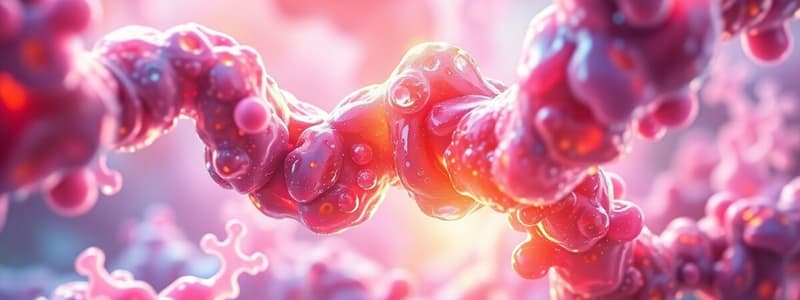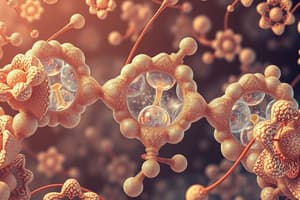Podcast
Questions and Answers
What characteristic feature is associated with the blue sclerae seen in Osteogenesis Imperfecta?
What characteristic feature is associated with the blue sclerae seen in Osteogenesis Imperfecta?
- Thickened scleral tissue
- Increased collagen production
- Decreased collagen content (correct)
- Absence of the choroid layer
Which type of Osteogenesis Imperfecta is associated with lethal outcomes in infancy?
Which type of Osteogenesis Imperfecta is associated with lethal outcomes in infancy?
- Type 1 OI
- Type 4 OI
- Type 3 OI
- Type 2 OI (correct)
What radiographic finding is commonly observed in a fetus with lethal type 2 Osteogenesis Imperfecta?
What radiographic finding is commonly observed in a fetus with lethal type 2 Osteogenesis Imperfecta?
- Normal skeletal structure
- Hyperplasia of bone tissue
- Numerous fractures of virtually all bones (correct)
- Minimal fractures
What is one of the main effects of decreased collagen content in Osteogenesis Imperfecta?
What is one of the main effects of decreased collagen content in Osteogenesis Imperfecta?
Which description best characterizes the skeletal changes observed in a fetus with lethal type 2 Osteogenesis Imperfecta?
Which description best characterizes the skeletal changes observed in a fetus with lethal type 2 Osteogenesis Imperfecta?
What stabilizes the association of proteoglycan monomers with hyaluronic acid?
What stabilizes the association of proteoglycan monomers with hyaluronic acid?
Which statement about glucuronic acid is correct?
Which statement about glucuronic acid is correct?
Which of the following is a non-sulfated glycosaminoglycan (GAG)?
Which of the following is a non-sulfated glycosaminoglycan (GAG)?
What is the primary localization of chondroitin sulfate?
What is the primary localization of chondroitin sulfate?
Which of the following best describes the function of heparin?
Which of the following best describes the function of heparin?
What is the role of GAGs in the extracellular matrix (ECM)?
What is the role of GAGs in the extracellular matrix (ECM)?
Where is the core protein synthesized?
Where is the core protein synthesized?
What type of bond is formed between xylose and the OH group of Serine?
What type of bond is formed between xylose and the OH group of Serine?
What is required for the hydroxylation of proline and lysine during collagen synthesis?
What is required for the hydroxylation of proline and lysine during collagen synthesis?
Which of the following steps occurs after the formation of the triple helix in collagen synthesis?
Which of the following steps occurs after the formation of the triple helix in collagen synthesis?
What occurs during the cross-link formation in collagen synthesis?
What occurs during the cross-link formation in collagen synthesis?
What does a deficiency in Vitamin C lead to in collagen formation?
What does a deficiency in Vitamin C lead to in collagen formation?
Which collagen types are associated with variable presentations of collagen disorders?
Which collagen types are associated with variable presentations of collagen disorders?
What is the consequence of having mutant chains in collagen?
What is the consequence of having mutant chains in collagen?
What condition can result from defective collagen synthesis due to Vitamin C deficiency?
What condition can result from defective collagen synthesis due to Vitamin C deficiency?
Collagen fibrils spontaneously associate to form which of the following?
Collagen fibrils spontaneously associate to form which of the following?
What is the primary defect associated with the classic form of Ehlers-Danlos Syndrome (EDS)?
What is the primary defect associated with the classic form of Ehlers-Danlos Syndrome (EDS)?
Which of the following features is NOT commonly associated with Ehlers-Danlos Syndromes (EDS)?
Which of the following features is NOT commonly associated with Ehlers-Danlos Syndromes (EDS)?
What is the most serious form of Ehlers-Danlos Syndrome characterized by arterial rupture?
What is the most serious form of Ehlers-Danlos Syndrome characterized by arterial rupture?
What genetic mutations most commonly cause Osteogenesis Imperfecta (OI)?
What genetic mutations most commonly cause Osteogenesis Imperfecta (OI)?
What is a common clinical feature of both Ehlers-Danlos Syndrome and Osteogenesis Imperfecta?
What is a common clinical feature of both Ehlers-Danlos Syndrome and Osteogenesis Imperfecta?
Which collagen type is primarily deficient in Osteogenesis Imperfecta?
Which collagen type is primarily deficient in Osteogenesis Imperfecta?
What consequence does the defect in type V collagen have on other collagen types?
What consequence does the defect in type V collagen have on other collagen types?
What is a characteristic feature of the vascular form of Ehlers-Danlos Syndrome?
What is a characteristic feature of the vascular form of Ehlers-Danlos Syndrome?
What is the primary function of articular cartilage?
What is the primary function of articular cartilage?
Which of the following components primarily makes up the extracellular matrix?
Which of the following components primarily makes up the extracellular matrix?
What is one function of glycoproteins in the extracellular matrix?
What is one function of glycoproteins in the extracellular matrix?
What happens when there is a loss of articular cartilage?
What happens when there is a loss of articular cartilage?
Which type of bond links oligosaccharides to proteins in glycoproteins?
Which type of bond links oligosaccharides to proteins in glycoproteins?
What characteristic distinguishes proteoglycans from glycoproteins?
What characteristic distinguishes proteoglycans from glycoproteins?
What role do chondrocytes play in relation to the extracellular matrix?
What role do chondrocytes play in relation to the extracellular matrix?
Which of the following statements about extracellular matrix is true?
Which of the following statements about extracellular matrix is true?
What is articular cartilage?
What is articular cartilage?
Which of the following functions are provided by the extracellular matrix (ECM)? (Select all that apply)
Which of the following functions are provided by the extracellular matrix (ECM)? (Select all that apply)
Glycoproteins contain a higher amount of carbohydrates compared to proteoglycans.
Glycoproteins contain a higher amount of carbohydrates compared to proteoglycans.
What is the primary function of glycosaminoglycans (GAGs)?
What is the primary function of glycosaminoglycans (GAGs)?
Which type of glycosidic bond is formed between the sugar and serine or threonine in O-linked glycoproteins?
Which type of glycosidic bond is formed between the sugar and serine or threonine in O-linked glycoproteins?
What is the most abundant protein in the human body?
What is the most abundant protein in the human body?
What deficiency is associated with Osteogenesis Imperfecta (OI)?
What deficiency is associated with Osteogenesis Imperfecta (OI)?
The two most abundant glycosaminoglycans are __________ and __________.
The two most abundant glycosaminoglycans are __________ and __________.
What clinical condition is characterized by fragile, hyperextensible skin and hypermobile joints?
What clinical condition is characterized by fragile, hyperextensible skin and hypermobile joints?
Flashcards are hidden until you start studying
Study Notes
Clinical Relevance of Articular Cartilage
- Articular cartilage is a connective tissue that enables smooth movement between bones.
- Loss of cartilage can lead to increased friction, resulting in pain, stiffness, and swelling, as seen in osteoarthritis.
Extracellular Matrix (ECM)
- ECM is a non-cellular component consisting of a complex network, including collagen, glycoproteins, and proteoglycans.
- Functions include providing structural support, mechanical strength, shock absorption, and facilitating cell signaling and adhesion.
Components of ECM
- Collagen: Provides structural integrity, firmness, and strength to tissues.
- Proteoglycans and Glycosaminoglycans (GAGs): Contribute to the gel-like consistency of the matrix, absorbing shock and resisting compression.
- Chondrocytes: Specialized cells that produce ECM components.
Glycoproteins
- Glycoproteins are proteins with carbohydrate chains; they are essential for cell communication, immune responses, and stability in circulation.
- They differ from proteoglycans in carbohydrate content and structure; glycoproteins have shorter, branched carbohydrates, while proteoglycans contain longer, unbranched carbohydrates.
Formation and Role of Glycoproteins
- Oligosaccharides in glycoproteins link through N- or O-glycosidic bonds.
- They participate in ECM composition, cell-cell communication, and overall tissue functionality.
Proteoglycan Aggregate Formation
- Proteoglycans associate with hyaluronic acid to form aggregates, vital for cartilage ECM, stabilized by link proteins.
GAGs and Their Functions
- Hyaluronic Acid: Present in synovial fluid and the ECM; crucial for tissue hydration and shock absorption.
- Chondroitin Sulfate: Most abundant GAG; found in cartilage and connective tissues; helps bind collagen fibers.
- Heparan Sulfate: Found in cell membranes and basement membranes; facilitates cell adhesion and growth factor binding.
- Dermatan Sulfate: Provides strength to skin, blood vessels, and tendons.
Collagen Synthesis
- Collagen is synthesized in the rough endoplasmic reticulum (RER) and undergoes post-translational modifications, including hydroxylation of proline and lysine (requiring vitamin C).
- Collagen molecules form triple helices and are secreted as procollagen, which is cleaved into tropocollagen in the ECM.
- Cross-linking forms mature collagen fibers, requiring copper as a cofactor.
Collagen Disorders
- Mutations in collagen genes can lead to various disorders, impacting collagen structure and function.
- Ehlers-Danlos Syndromes (EDS): Characterized by hyperextensible skin and joints, varying forms associated with different collagen types.
- Osteogenesis Imperfecta (OI): A genetic disorder resulting from type I collagen deficiency, leading to fragile bones and additional symptoms affecting various tissues.
Importance of Vitamin C
- Vitamin C deficiency impairs collagen synthesis, resulting in conditions like scurvy, characterized by capillary fragility and visible bruising.
Clinical Relevance of Articular Cartilage
- Articular cartilage is a connective tissue that facilitates smooth movement between bones.
- Loss of cartilage leads to increased friction, resulting in pain, stiffness, and swelling, commonly seen in conditions like osteoarthritis.
Extracellular Matrix (ECM)
- ECM is a non-cellular component comprising collagen, glycoproteins, and proteoglycans that supports cell structure.
- Functions include providing structural support, elasticity, tensile strength, shock absorption, and facilitating cell signaling.
Components of ECM
- Collagen: Offers firmness and strength to connective tissues.
- Proteoglycans: Contributes to the gel-like consistency of ECM, crucial for shock absorption and compression resistance.
- Chondrocytes: Specialized cells responsible for producing ECM components.
Glycoproteins
- Glycoproteins consist of protein molecules with attached carbohydrates, crucial for cell communication and adhesion.
- They play roles in immune response, cell surface recognition, and include various hormonal functions.
- Glycoproteins vs. Proteoglycans: Glycoproteins have shorter carbohydrates, while proteoglycans have long, unbranched chains.
Structure and Synthesis of Glycoproteins
- Glycoprotein structure involves oligosaccharides linked to proteins via N- or O-glycosidic bonds.
- N-linked glycoproteins undergo initial glycosylation in the endoplasmic reticulum (ER) and complete it in the Golgi apparatus.
- O-linked glycoproteins gain their modifications primarily in the Golgi.
Glycosaminoglycans (GAGs) and Proteoglycans
- GAGs are unbranched polysaccharide chains that provide structural support within ECM.
- Proteoglycans consist of core proteins linked to GAGs, functioning as lubricants in connective tissues.
Types and Functions of GAGs
- GAGs include hyaluronic acid, chondroitin sulfate, heparin, keratan sulfate, heparan sulfate, and dermatan sulfate.
- GAGs have a charge that allows them to absorb shock, reduce friction, and provide flexibility in the ECM.
Collagen Structure and Function
- Collagen is the predominant protein in the body, formed as a triple helical structure, essential for tissue support.
- Synthesis involves several steps: prepro–α chains, hydroxylation, glycosylation, and ultimately forming collagen fibrils.
- Proper synthesis is crucial; deficiencies or mutations can lead to various collagen disorders.
Collagen Disorders
- Mutations in collagen genes can result in diseases such as Ehlers-Danlos Syndromes (EDS) and Osteogenesis Imperfecta (OI), characterized by skin hyperextensibility, joint hypermobility, and fragile bones.
- EDS has several forms, with clinical manifestations ranging from skin and joint issues to serious vascular complications.
- OI results from deficiencies in type I collagen, leading to brittle bones and increased fractures.
Key Takeaways
- Both glycoproteins and proteoglycans are essential for ECM functionality, stability, and biological processes.
- Understanding the structures and functions of these components is vital for addressing related diseases and conditions.
Studying That Suits You
Use AI to generate personalized quizzes and flashcards to suit your learning preferences.




